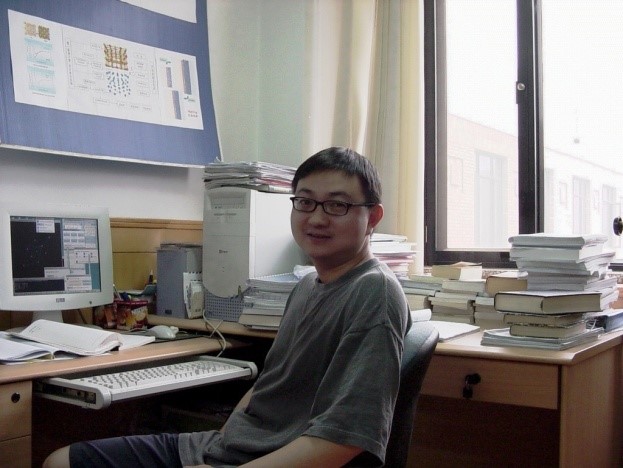
Professor, master tutor
(Data Last updated Jan. 1, 2016)
Zhang Shuo, male, doctor, professor (level 4), master supervisor. Using Chen-Möbius multi-lattice inversion number theory method, mainly engaged in ionic crystals, rare earth intermetallic compounds, transition metals, compound semiconductors, nuclear reactor wall materials and Ge-Sb-Te phase change storage materials and ultra Computational simulation research and development work on the direction of the interaction potential between atoms related to the crystal structure evolution of hard materials.
Main educational background:
Main educational background:
|
Education
|
time
|
Graduated school
|
profession
|
Bachelor of Science
|
|
Undergraduate
|
1986.9—1990.7
|
Huazhong University of Science and Technology*
|
Semiconductor Physics and Devices
|
Bachelor
|
|
master's degree
|
1990.9—1993.7
|
Huazhong University of Science and Technology
|
Semiconductor devices and microelectronics technology
|
Master of Engineering
|
|
PhD
|
1999.3—2003.3
|
Tsinghua University
|
Condensed Matter Physics
|
Doctor of Science
|
*Currently Huazhong University of Science and Technology
Study abroad experience:
In 1999, he went to the Mitsuto Laboratory of Okakami University of Science in Japan to conduct environmental functional materials research;
In 2005, he was supported by the National Funding Committee's basic course teachers' overseas training fund support, and went to the University of Illinois in the United States for teaching method training and obtained a certificate.
Research topics:
1. From 2011 to 2015, as an academic backbone, he participated in the 973 project: The name of the subject in the scientific basic problems of performance-oriented material integrated design: Material Atomic Potential Library Innovation Service System (No.: 2006CB605101);
2. In 2006-2010, as an academic backbone, he participated in the 973 project: a topic in the basic scientific issues of material design based on integrated computing: the innovation and expansion of the potential library of interactions between atoms in complex materials (topic number: 2011CB606401);
Award status:
Won the 2006 Wu Daguan Outstanding Teacher Award from Yunnan University.
The first author published an article:
In 1999, he went to the Mitsuto Laboratory of Okakami University of Science in Japan to conduct environmental functional materials research;
In 2005, he was supported by the National Funding Committee's basic course teachers' overseas training fund support, and went to the University of Illinois in the United States for teaching method training and obtained a certificate.
Research topics:
1. From 2011 to 2015, as an academic backbone, he participated in the 973 project: The name of the subject in the scientific basic problems of performance-oriented material integrated design: Material Atomic Potential Library Innovation Service System (No.: 2006CB605101);
2. In 2006-2010, as an academic backbone, he participated in the 973 project: a topic in the basic scientific issues of material design based on integrated computing: the innovation and expansion of the potential library of interactions between atoms in complex materials (topic number: 2011CB606401);
Award status:
Won the 2006 Wu Daguan Outstanding Teacher Award from Yunnan University.
The first author published an article:
1. Shuo Zhang, Nanxian Chen, (2002),Ab initio interionic potentials for NaCl by multiple lattice inversion, Physical Review B66, 064106
2. Shuo Zhang, Nanxian Chen, (2003),Lattice inversion for interionic pair potentials, Journal of Chemical Physics118, 3974
3. Shuo Zhang, (2003),Nanxian Chen, Determination of the B1-B2 transition path in RbCl by Mobius pair potentials, Philosophical Magaazine 83(12),1451
4. Shuo Zhang, Nanxian Chen, (2003),Energies and stabilities of sodium chloride lusters based on inversion pair potentials, Physica B325, 172
5. Shuo Zhang, Nanxian Chen, (2003),Molecular dynamics simulations for high-pressure induced B1-B2 transition in NaCl by Mobius pair potentials , Modelling Simul. Mater. Sci. Eng.11(3):331-338
6. Shuo Zhang, Nanxian Chen, (2003),Study on the high-pressure properties of KCl crystal by inversion pair potentials, Materials Science and Engineering B99, 588
7. Shuo Zhang, Nanxian Chen, (2003),Atomistic simulations of B1-B2 phase transition in KCl based on inversion pair potentials, Acta Materilia 51/20, 6151
8. Shuo Zhang, Nanxian Chen, (2005), Lattice inversion for interatomic potentials in AlN, GaN and InN, Chem. Phys. 309,309-321
Main research directions:
1. Based on the Finnis-Sinclair form of embedded atom interaction potential model, the simple primary calculation result is used as the data source, and the double lattice inversion method is used to study the interatomic interaction potential of metals and intermetallic compounds; The calculations of molecular mechanics, molecular dynamics and lattice dynamics provide atomic-level images related to phase stability, high-pressure phase transition and low-dimensional nanostructure evolution, and illustrate the atomic configuration relationship of structural performance changes;
2. Using the multi-lattice inversion method, combined with the variable charge model, obtain the effective interatomic interaction potential that reflects the charge, establish a compound semiconductor interatomic interaction potential library, and describe low-dimensional nanostructures with large-scale atomic-level simulations The formation mechanism;
3. On the basis of empirical atom interaction potential, expand the lattice inversion method to interstitial structure, obtain effective interaction potential between atoms of nuclear reactor wall materials such as Be-W and Fe-He, and reveal the atoms that determine the safety of nuclear reactor materials Diffusion mechanism
4. On the basis of the wrinkle and stress structure evolution of low-dimensional atomic structure materials, the lattice inversion method is further used to obtain the interaction potential between atoms that can reflect the sp3→sp2 chemical bond properties, and to show the atomic structure of low-dimensional materials with different scales and boundary conditions The law of evolution.
1. Based on the Finnis-Sinclair form of embedded atom interaction potential model, the simple primary calculation result is used as the data source, and the double lattice inversion method is used to study the interatomic interaction potential of metals and intermetallic compounds; The calculations of molecular mechanics, molecular dynamics and lattice dynamics provide atomic-level images related to phase stability, high-pressure phase transition and low-dimensional nanostructure evolution, and illustrate the atomic configuration relationship of structural performance changes;
2. Using the multi-lattice inversion method, combined with the variable charge model, obtain the effective interatomic interaction potential that reflects the charge, establish a compound semiconductor interatomic interaction potential library, and describe low-dimensional nanostructures with large-scale atomic-level simulations The formation mechanism;
3. On the basis of empirical atom interaction potential, expand the lattice inversion method to interstitial structure, obtain effective interaction potential between atoms of nuclear reactor wall materials such as Be-W and Fe-He, and reveal the atoms that determine the safety of nuclear reactor materials Diffusion mechanism
4. On the basis of the wrinkle and stress structure evolution of low-dimensional atomic structure materials, the lattice inversion method is further used to obtain the interaction potential between atoms that can reflect the sp3→sp2 chemical bond properties, and to show the atomic structure of low-dimensional materials with different scales and boundary conditions The law of evolution.
job title



